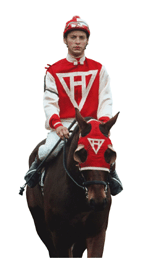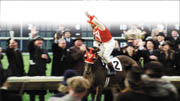Ah, Hollywood
The glamorous life of a bluegrass P.A.
on the set of Seabiscuit
By Jamie Robinson
Racing season starts early this year, at least on the silver screen. And no one awaits the national opening of Seabiscuit with more anticipation than Bluegrass residents. With Tobey Maguire, Jeff Bridges, and Academy Award winner Chris Cooper, the potential's all there.

Universal Studios
Seabiscuit, was a direct descendent of the legendary racehorse Man O' War (which Lexington's congested outer loop was named after) though you'd never have known by his stature.
He was only about 15 hands tall, short for a race horse, and his knees didn't straighten all the way, so that when he ran one of his legs bowed out. They said he had an eggbeater's gate. A small, knobby-kneed, bow-legged horse isn't usually the stuff legends are made of, and Seabiscuit was at the bottom of the racing food chain-largely dismissed by the industry.
It wasn't until a series of chance meetings that racing history would change forever. The then three-year-old horse was seen by trainer, Tom Smith, bought by automobile giant Charles Howard, and paired with an oversized jockey with a dismal winning record, Johnny "Red" Pollard. The unlikely team created the right combination for the champion Seabiscuit to emerge.
The Introduction
Last Labor Day, I stopped in a Florida bookstore and was first introduced to Laura Hillenbrand's best seller, Seabiscuit: An American Legend. Intrigued by the odd name, I picked it up and read the jacket-which is how I learned of an unlikely hero Depression Era America took to heart.
Now, I know you're thinking I bought and read the book that very day and it changed my life, and so on but, well I'm poor and so I put it back thinking it would be an interesting read to pick up at the library when I got back home. Little did I know that Seabiscuit was soon to be the preoccupation of my life.
As chance would have it, I was available for employment in October, just when the Kentucky Seabiscuit Production office at 928 Nandino Blvd. was gearing up for the arrival of the entire company for two weeks of filming in early November at Keeneland, Calumet, Eastern State Hospital, and some locations in Paris.
An overworked assistant production office coordinator (APOC), Christie Kwan, was in need of another production assisstant to help her and the other office PA, Brandy Mott, turn a previously empty warehouse into the epicenter, the home base of all Seabiscuit happenings in Kentucky.
A friend referred me and the rest, as they say, is showbiz.
I was green, but I do know my way around an office, and that's an important skill to have in a production office. We went through so much paper I ordered two industrial size recycling bins from the city for the copy room.
As my job progressed I learned more: collating scripts, the paper color order for revisions, and most importantly, memorizing the numeric designation of New Circle Road (the 4, if you were wondering) because the Los Angeles natives who were used to taking the 405 and the 10 to get around in L.A. responded better to directions with numbers (less so to how our roads suddenly "become" different roads. Limestone "becomes" Nicholasville and at another point it almost "becomes" Upper.)

On the Scene
The Kentucky production office was unique.
Normally, the production office is in a hotel room. People call for information, things get faxed and mailed in and out (an obscene amount of FedEx) and the hotel's generally a touchstone between the L.A. office and location shooting. That's how the Saratoga Springs Seabiscuit production office operated-with all the other deparments like construction, art, set-decoration, and greens warehoused elsewhere.
Kentucky was a "horse of a different color."
Every department was warehoused at Nandino.
We had a sophisticated phone system with lines for all the departments and extensions for everyone in those departments as well as DSL lines running throughout the building. This was all taken back out when we left. We also had accounts set up with vendors all over town because we had to rent all our furniture, office machines, and the all important coffee makers, highly needed when your day starts before the sun comes up.
For two months I worked a little over 80 hours a week with only a couple of days off before filming commenced. On average, I would get to the office at 5am and leave around 7:30 or 8pm.
Don't park in the shot
Among my official job duties of copying, faxing, answering phones, making deliveries to set, and making sure things were getting done when they needed to get done, I was also the resident Lexingtonian who served as de facto concierge.
On a side note to making set deliveries, one of the first things to remember when going to the set of a major motion picture: never park your car in the shot.
(I learned that lesson the hard way when I a made a delivery to the Calumet Farm setand held up the filming of a scene between Jeff Bridges and Chris Cooper. Everyone was really nice about it though.)
This whole experience made my little movie geek heart live a dream.
Everday, I walked through the costume department to see all the vintage clothing that the extras would be wearing, then I moved on into the construction area where props like a huge Pimlico sign were being made to transform Keeneland's toteboard to look like Pimlico's in 1938. Hollywood magic was alive and well right here in Lexington and I had a backstage pass.
Working for some of the most respected and talented people making movies today was eye-opening because I was able to see what it really takes to get a movie of this magnitude made.
It's not everyday that your office is two doors down from producers Frank Marshall and Kathleen Kennedy, and right down the hall from editor Billy Goldenberg (Ali) working on a state of the art AVID editing machine, putting the film together.
The thouroughbred industry is such a part of this community that being a part of a project that is special to the people of Kentucky was amazing.
The entire city was so pivotal in making the production end of the movie making process run smoothly because we did use so many local vendors, and of course, all those wonderful extras.
It was one of the most stressful, adrenaline filled, and wonderful experiences of my life, so far. I mean, I got to dance to Gloria Gaynor's disco anthem of overcoming hardship (Seabiscuit would be proud) "I Will Survive" with Kingston DuCoeur who plays Sam, and some of the other PAs at the cast and crew party at the Marriot.
By then, the team had become our own little world.
The company packed up and headed to Santa Anita to continue filming on November 19, 2002. Some crew stayed behind to pack up their departments, but within a few days they were all gone too.
This left Christie, Brandy, and me to close up shop.
We cleaned out everything, and by the time we were done, you would never known we had been there. We locked the door for the final time two days before Thanksgiving. All that was left was a big empty warehouse and a lifetime of memories.
Thank you Seabiscuit.
The Action Figure!
 |
|
|
Now, 65 years later, he is grabbing headlines again.
The success of Laura Hillenbrand's book and the subsequent film adaptation due out in late July has started everyone talking again about the little horse that could.
While filming part of the Universal picture here in the Bluegrass, local news media couldn't get enough as articles and television reports came out on a regular basis. Nationally, The Los Angeles Times did a large spread in January, E! entertainment television features the trailer in Coming Attractions, lavish print ads are on-stands now in Vanity Fair (their FanFare page features a photo of jockey Gary Stevens winner of 4,500 races, making his acting debut in the movie), and the Boston-produced PBS special American Experience Seabiscuit, aired this past April, and will air again on KET2 on Monday, July 28 at 9 pm and Sunday, August 3 at 9 pm on KET1. You can even buy your own Seabiscuit figure from Petsmart in the Hamburg Pavilion.
Seabiscuit banners are already flying in downtown Lexington in advance of the movie's debut.
The film cost $50 million to make-more than Seabiscuit earned in his lucrative racing career-but his story of overcoming the odds and inspiring the people of the depression era is what Hollywood heavyweights are banking on to move this film into the winner's circle at the box office, and maybe even beyond.
-JR
Seabiscuit will premiere in Lexington, Saturday, July 19th at the Kentucky Theatre at 6pm. There is also a cast party later that night at 9:30pm. But both events have already sold out. The movie will be released in theaters nationwide on July 25th.
Behind the Screen
 The big screen experience of Seabiscuit will soon be at the multiplex.
The big screen experience of Seabiscuit will soon be at the multiplex.
The adaptation of Laura Hillenbrand's bestseller Seabiscuit: An American Legend debuts with a special advance screening at the Kentucky Theatre July 19, then opens nationally on July 25.
Along the way was a lot of planning and 4,000 extras braving the bitter cold, one November Sunday at Keeneland Race Course.
The story of Seabiscuit begins in 1933, when he was foaled. The story of the Universal Motion Pictures, DreamWorks, and Spyglass Entertainment's Seabiscuit begins in 1998.
An article Hillenbrand had written for American Heritage magazine sparked a bidding war in Hollywood over control of the movie rights.
Hillenbrand told The Los Angeles Times in January that she chose writer/director/producer Gary Ross for Seabiscuit, because "he understood this is not just a horse story, this is a human story and the focus should really be on the people."
Ross's screenwriting credits include Big and Dave, both of which earned him Oscar nominations. He also wrote and directed Pleasantville, introducing him to Tobey Maguire, who'd turn out to be Ross' first choice to play Seabiscuit's jockey Red Pollard.
The Bluegrass's relationship with the movie started when locations in Cincinnati were scrapped in favor of Lexington and Paris. California native Christie Kwan, the assistant production office coordinator was then given the task of setting up the Kentucky Production office in an old warehouse on Nandino Blvd in late September.
The production office became a miniature Hollywood amidst the rolling hills of the Bluegrass. With several departments accounted for: construction, costume, hair/make-up, art, set-decoration, greens, accounting, extras-casting, and a well stocked craft services table in the office, everyone worked day and night to prepare for the arrival of the cast and the rest of the crew for two weeks of filming in November.
Sunday November 18 was the biggest and final day of filming in Kentucky, with Keeneland doubling for Pimlico.
Not to spoil the plot (for the three of you who haven't read the book or seen the documentary), but that was the day the film crew would recreate one of the greatest moments in racing history: the day when Seabiscuit, the Depression Era's working class underdog hero, would beat the well-bred and beautiful War Admiral.
It was about 36 degrees outside while 4,000 extras, some paid but most not, stood around from the early morning hours until late in the day. Although the frigid temps and wind gusts at the track were almost unbearable, few left because they knew they were taking part in something big.
With Oscar buzz already circulating pre-release, looks like they were right.
-JR
HOME | THIS ISSUE | ACE ARCHIVES